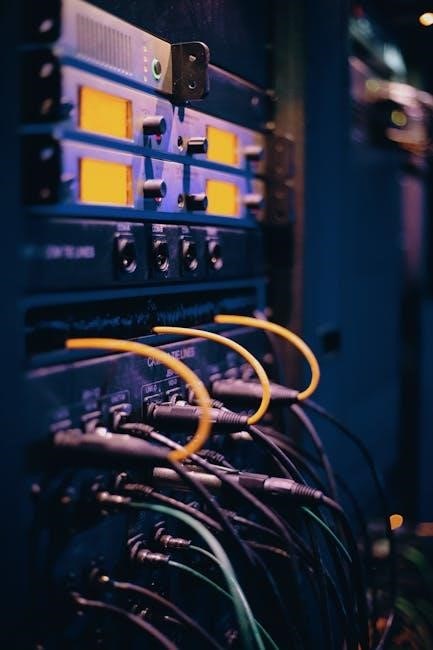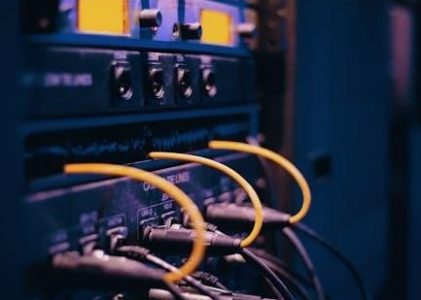Three-way switches enable control of a light fixture from two locations, enhancing convenience. Wiring diagrams provide clear visual guidance, essential for safe and correct installations, ensuring functionality and compliance with electrical standards.
1.1 Overview of Three-Way Switches
A three-way switch is an electrical device enabling control of a light fixture from two different locations. It features three terminals: one common terminal and two traveler terminals. The common terminal connects to the power source or the light fixture, while the traveler terminals connect the two switches. This setup allows the light to be turned on or off from either switch. Three-way switches are commonly used in hallways, staircases, or large rooms for added convenience. Wiring diagrams are essential for proper installation, as they illustrate how to connect wires between switches and the light fixture. These diagrams ensure safe and functional wiring, adhering to electrical codes.
1.2 Importance of Wiring Diagrams for Three-Way Switches
Wiring diagrams are crucial for installing three-way switches, providing a clear, visual guide to ensure correct connections. They detail how to link the common, traveler, and ground wires between switches and the light fixture. Without a diagram, the risk of errors increases, potentially leading to safety hazards or malfunctioning setups. Diagrams also simplify the process for DIY enthusiasts and electricians, saving time and reducing confusion. They act as a reference point, ensuring compliance with electrical codes and best practices. By following a diagram, one can avoid common mistakes, such as misconnecting traveler wires or failing to identify the common terminal, thus ensuring a safe and functional installation.
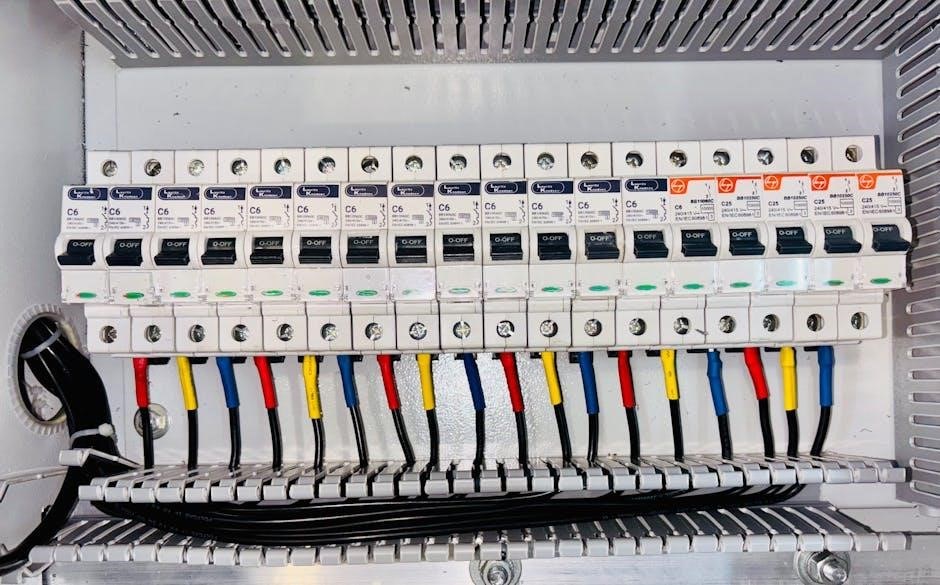
1.3 Brief History of Three-Way Switch Configurations
The concept of three-way switches dates back to the late 19th century, evolving from basic toggle switches. Initially, they were simple on-off devices, but the need for controlling lights from multiple locations drove innovation. By the early 20th century, three-way switches became standard, enabling two switches to operate a single light fixture. Wiring diagrams emerged as essential tools, helping electricians and DIYers understand complex connections. Over time, configurations expanded to include four-way switches and multiple light setups. Today, three-way switches are a fundamental component in residential and commercial wiring, with diagrams serving as critical guides for safe and efficient installations.

Materials and Tools Required for Three-Way Switch Wiring
Essential materials include three-way switches, 12-3 or 14-3 wire, junction boxes, and wire connectors. Tools needed are screwdrivers, pliers, wire strippers, and a voltage tester for safety.
2.1 List of Necessary Materials
To successfully wire a three-way switch, you’ll need specific materials. These include a three-way switch, 12-3 or 14-3 wire with ground, junction boxes, and wire connectors. Additionally, ensure you have a voltage tester, screwdrivers, pliers, and wire strippers. For grounding, copper pigtail wires are essential. Neutral wires (typically white) and traveler wires are also required. If connecting multiple lights, appropriate light fixtures and mounting hardware are needed. Safety gear like gloves and safety glasses should always be on hand. Proper materials ensure a safe, efficient, and code-compliant installation. Gather all items before starting to avoid delays during the wiring process.
2.2 Essential Tools for the Job
Having the right tools is crucial for safely and effectively wiring a three-way switch. Essential tools include wire strippers for removing insulation, a voltage tester to verify power status, and screwdrivers (both flathead and Phillips) for securing wires. Pliers are necessary for gripping and bending wires, while a utility knife can cut wire insulation. A drill and bits may be needed for running wires through walls. Wire connectors and a pigtail connector are also essential for secure connections. Safety gear like gloves and safety glasses should always be worn. These tools ensure precision, safety, and efficiency when working with electrical systems.
2.3 Safety Equipment and Precautions
Safety is paramount when working with electrical systems. Always turn off power at the circuit breaker before starting the project. Use a voltage tester to confirm no electricity flows through the wires. Wear insulated gloves and safety glasses to protect against shocks and debris. Ensure proper ventilation and avoid working in damp conditions. Keep a fire extinguisher nearby and never overload circuits. Label all wires clearly to avoid confusion. Follow local electrical codes and consult a professional if unsure. These precautions minimize risks and ensure a safe working environment, preventing accidents and injuries. Always prioritize caution when handling live wires and electrical components.

Understanding the Three-Way Switch Wiring Diagram
A three-way switch wiring diagram visually represents the circuit, showcasing terminals, wires, and connections. It highlights traveler wires, common terminals, and load connections, aiding in installations and troubleshooting effectively.
3.1 How to Read a Three-Way Switch Wiring Diagram
Reading a three-way switch wiring diagram begins by identifying key components: the switches, light fixture, and wires. Locate the common terminal, traveler wires, and ground connections. Start from the power source, tracing how electricity flows through the circuit. Understand that one switch controls the power supply, while the other operates the traveler wires. Pay attention to symbols, such as brass terminals for hot wires and silver for neutrals. Ensure all connections align with the diagram to avoid short circuits. Practice on a diagram before wiring to ensure clarity and safety during the installation process.
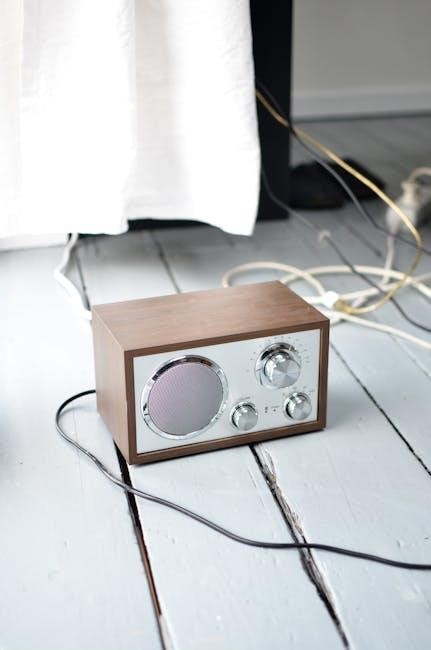
3.2 Key Components of the Diagram
The three-way switch wiring diagram includes essential elements: the switches, light fixture, power source, and wires. The switches have three terminals: common, traveler, and ground. The light fixture is central, controlled by the switches. Power enters through one switch, connecting to the common terminal. Traveler wires link the two switches, enabling control from both locations. Ground wires ensure safety. The diagram also shows connections between terminals, highlighting how electricity flows through the circuit. Understanding these components is crucial for accurate wiring, ensuring the system functions properly and safely. Each part plays a specific role, making the diagram a clear guide for installation.
3.3 Common Symbols and Their Meanings
Wiring diagrams use standardized symbols to represent components. A three-way switch is shown as a rectangle with three terminals: one common (black) and two travelers (brass or silver). The light fixture is depicted as a circle or rectangle with a bulb inside. Power sources are marked with a circle or loop, indicating where electricity enters the circuit. Ground wires are shown as a diagonal line with a half-circle at the end. Traveler wires are represented by lines connecting the switches. These symbols help in identifying the role of each component, ensuring proper connections and safe wiring practices. Understanding these symbols is key to interpreting the diagram accurately.

Step-by-Step Wiring Process for a Three-Way Switch
Start by turning off power. Connect the common wire to the switch’s common terminal. Link traveler wires between switches and splice neutrals and grounds. Secure all connections.
4.1 Connecting the First Three-Way Switch
Begin by identifying the terminals on the three-way switch: common, traveler 1, and traveler 2. Connect the black (hot) wire to the common terminal, marked with a “COM” label. Next, attach the two traveler wires (typically red and yellow) to the remaining terminals. Ensure these connections are secure and not loose. Splice the neutral (white) wires together and ground the switch by connecting the bare copper wire to the grounding terminal. Double-check all connections and verify with a wiring diagram to ensure correctness. Properly securing these wires is crucial for safe and reliable operation of the switch. Always turn off power before starting work.
4.2 Wiring the Traveler Wires Between Switches
After connecting the first three-way switch, focus on wiring the traveler wires between the two switches. Identify the traveler terminals on both switches, typically marked as “1” and “2” or colored red and yellow. Connect one end of the traveler wires to the traveler terminals on the first switch and the other ends to the corresponding terminals on the second switch. Ensure the wires are securely attached to avoid loose connections. Use a wiring diagram to confirm the correct configuration. This step is critical for enabling the switches to control the light fixture from both locations. Properly routing these wires ensures smooth operation of the circuit.
4.3 Connecting the Light Fixture
Once the traveler wires are connected between the switches, focus on wiring the light fixture. Ensure the power is off and verify this with a voltage tester for safety. Connect the hot wire (typically black) from the second switch to the brass terminal on the light fixture. The neutral wire (white) should be connected to the silver terminal, and the ground wire (bare or green) to the grounding terminal on the fixture. Use wire nuts or connectors to secure all connections; Refer to the wiring diagram to confirm the correct configuration. Double-check all connections to ensure they are tight and properly insulated. Finally, turn the power back on and test the fixture to ensure it operates correctly from both switches.
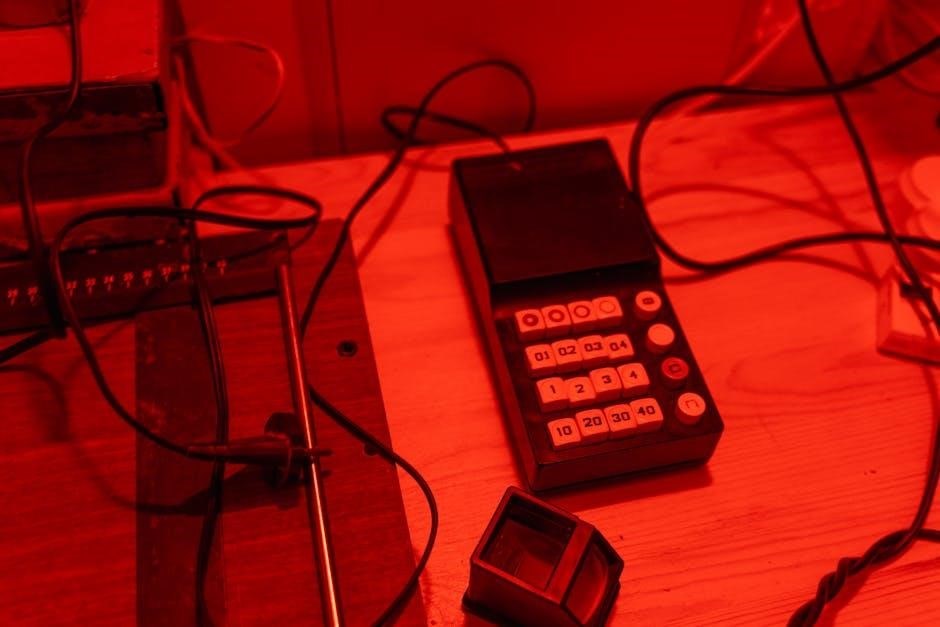
Common Configurations for Three-Way Switch Wiring
Three-way switches are commonly used to control lighting from two or three locations. Configurations include wiring with two lights, multiple lights, or integrating a four-way switch for expanded control. Diagrams provide visual guidance for these setups, ensuring NEC code compliance and proper functionality.
5.1 Wiring a Three-Way Switch with Two Lights
Wiring a three-way switch to control two lights involves connecting the switches and lights using traveler wires. Start by running a 14-3 cable between the two switches and the light fixtures. Identify the common terminal on each switch and connect it to the line (hot) wire. The traveler wires are connected between the switches, while the neutral wires are spliced together. Ensure the grounding wires are properly connected for safety. Use a wiring diagram to visualize the setup, and verify the connections with a voltage tester before powering on. This configuration allows both switches to independently control the two lights, providing flexibility and convenience in lighting control.
5.2 Configuring a Three-Way Switch with Multiple Lights
Configuring a three-way switch to control multiple lights involves extending the circuit while maintaining the core wiring principles. Start by connecting the common terminal on each switch to the line (hot) wire. The traveler wires are connected between the switches, and the neutral wires are spliced together at each junction box. For multiple lights, run 14-3 cables from the second switch to each light fixture, ensuring the traveler wires are shared between switches. Grounding wires must be properly connected at all points. This setup allows both switches to control all connected lights simultaneously, providing consistent lighting control across multiple fixtures. Always refer to a wiring diagram to ensure accuracy and safety.
5.3 Integrating a Four-Way Switch into the Circuit
Integrating a four-way switch into a three-way circuit allows control of a light fixture from three or more locations. The four-way switch acts as an intermediary, connecting two three-way switches. Wire the four-way switch by connecting its two brass terminals to the traveler wires running between the three-way switches. The remaining two terminals link to the common terminals of the three-way switches; Ensure the neutral and ground wires are properly spliced at each junction box. This configuration requires precise wiring to maintain functionality, so consulting a wiring diagram is crucial. Proper installation ensures seamless control of the light fixture from all connected switches, enhancing flexibility and convenience in lighting management.
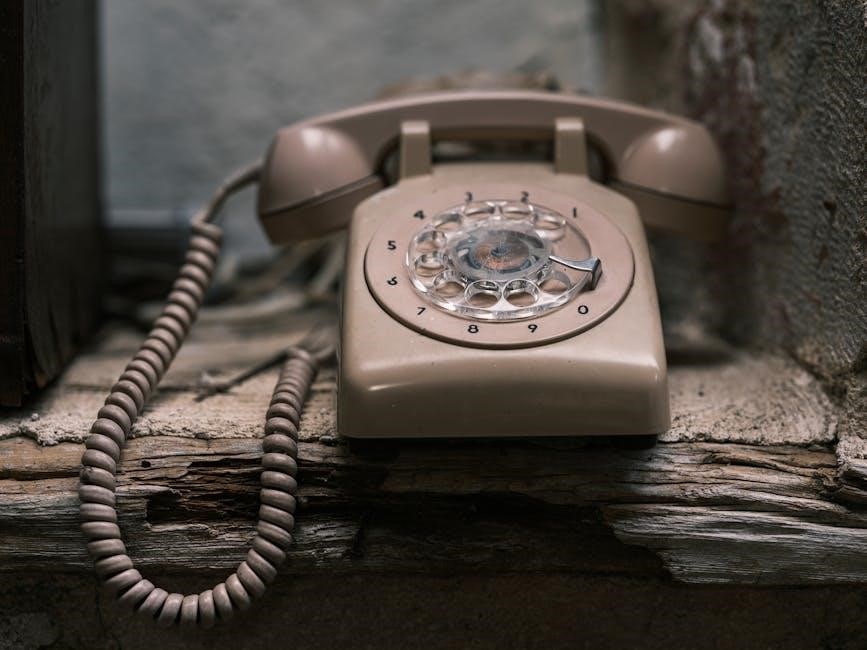
Troubleshooting Common Issues in Three-Way Switch Wiring
Identify common three-way switch wiring issues, such as short circuits or incorrect traveler wire connections. Use diagrams to diagnose and resolve problems efficiently, ensuring proper functionality and safety.
6.1 Identifying and Fixing Short Circuits
To identify short circuits in three-way switch wiring, turn off power and use a voltage tester to verify de-energized wires. Inspect for loose connections or wire damage. A short circuit occurs when a hot wire touches a neutral or ground, causing excessive current. Check traveler and common wires for unintended contact. Ensure no wires are pinched or exposed. If a short persists, trace wires back to their sources and verify connections at switches and fixtures. Correcting a short may involve replacing damaged wires or securing connections properly. Always consult a wiring diagram to confirm correct wire placements and avoid recurring issues.
6.2 Resolving Issues with Traveler Wires
Traveler wires, which connect the two three-way switches, are crucial for proper functionality. Issues often arise from incorrect connections or damaged wires. To resolve these, turn off power and verify wire connections using a wiring diagram. Check that traveler wires are securely attached to the correct terminals on both switches. If wires are damaged, replace them with appropriately rated cable. Ensure no wires are crossed or mislabeled, as this can disrupt the circuit. Testing the switches after repairs can confirm if the issue is resolved. Properly identifying and connecting traveler wires is essential for ensuring the circuit operates as intended.
6.3 Fixing a Light That Doesn’t Turn On
If a light controlled by a three-way switch doesn’t turn on, check the power supply and wiring connections. Verify that the light fixture itself is functioning by testing it with a known working bulb. Inspect the traveler and common wires for loose connections or damage. Use a voltage tester to ensure power is present at the switches and the fixture. If the issue persists, consult a wiring diagram to confirm proper connections. Ensure the common wire is correctly attached to the common terminal on both switches. If the light still doesn’t activate, the problem may lie in the circuit or the switches themselves, requiring replacement or professional assistance.
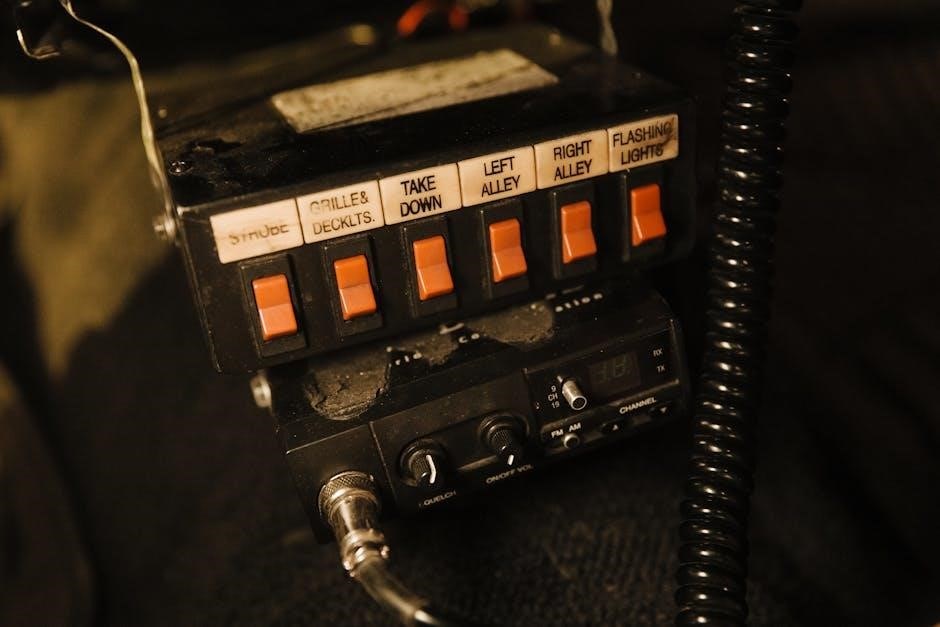
Safety Tips and Best Practices
Always turn off power at the circuit breaker before starting work. Use a voltage tester to confirm no live wires. Wear insulated gloves and safety goggles. Ensure all connections are secure and meet local electrical codes. Properly label wires to avoid confusion. Keep tools and materials organized to maintain a safe workspace. Follow the wiring diagram carefully to prevent errors. Never touch wires with bare hands or metal objects. Double-check all connections before restoring power. Consider consulting a licensed electrician if unsure about any step.
7.1 Turning Off Power Before Starting the Project
Always begin by switching off the power supply at the circuit breaker or fuse box. Verify the absence of electricity using a voltage tester. Secure the area to prevent accidental power restoration. Double-check that all wires are de-energized before handling them. This critical step ensures safety, preventing electrical shocks or fatalities. Label the breaker or fuse box to avoid confusion. Inform others in the household to avoid switching the power back on. Use a non-contact voltage tester for accurate readings. Never rely on the light switch to confirm power status. Ensure all tools and materials are ready before starting work. Safety should always be the top priority when working with electrical systems.
7.2 Using a Voltage Tester for Verification
Using a voltage tester is a critical step to ensure safety before starting any wiring project. This tool helps verify that no electricity is present in the wires or devices. Choose a non-contact voltage tester for convenience and accuracy. Simply hold the tester near the wires or switches to detect voltage. If the tester lights up or beeps, electricity is still present. Always test each wire individually to confirm they are de-energized. This step prevents accidental shocks or injuries. Never rely on visual inspections alone, as wires can carry power even if they appear inactive. A voltage tester is an essential tool for safe and reliable electrical work.
7.3 Proper Handling of Wires and Connections
Proper handling of wires and connections is vital for ensuring safety and reliability in three-way switch installations. Always use wire strippers to carefully remove insulation without damaging the conductors. When connecting wires, twist them tightly and secure with wire nuts or screw terminals. Labeling wires as “hot,” “neutral,” or “traveler” helps avoid confusion. Use pliers to bend wires for secure terminal connections. Avoid over-tightening, which can damage wires. For multi-conductor cables, use cable ties to keep them organized. After completing connections, double-check for loose ends or crossed wires. Proper handling prevents short circuits and ensures the system functions as intended. Regularly inspect connections to maintain safety and performance.

Resources and References
Consult official three-way switch wiring diagrams, YouTube tutorials, and electrical codes for detailed guidance. Utilize PDF guides and online forums for troubleshooting and advanced configurations.
8.1 Recommended PDF Guides for Three-Way Switch Wiring
Download comprehensive PDF guides for three-way switch wiring, featuring detailed diagrams and step-by-step instructions. These resources often include troubleshooting tips, safety guidelines, and code compliance information. Many guides are designed for DIY enthusiasts and professionals alike, covering various configurations such as single and multiple light setups. They typically include clear illustrations of wire connections, traveler wires, and common terminals. Some PDFs also address advanced topics like integrating four-way switches and maintaining NEC standards. These guides are invaluable for ensuring accurate and safe installations. Look for highly-rated PDFs from reputable sources to enhance your understanding and confidence in wiring projects.
8.2 Online Tutorials and Video Guides
Online tutorials and video guides provide hands-on instruction for wiring three-way switches. Platforms like YouTube offer detailed step-by-step videos, showcasing real-world applications. These resources often include animations and live demonstrations, making complex concepts easier to grasp. Many tutorials cover troubleshooting common issues, such as short circuits or faulty traveler wires. They emphasize safety practices, like using voltage testers, and provide tips for maintaining code compliance. Whether you’re a DIY enthusiast or a professional, these guides offer practical insights and visual learning opportunities. They are especially useful for understanding how to connect multiple lights or integrate four-way switches into your circuit. These resources are invaluable for mastering three-way switch wiring projects successfully.
8.3 Electrical Codes and Standards
Adhering to electrical codes and standards is crucial when wiring three-way switches. The National Electric Code (NEC) provides guidelines to ensure safety and proper installation. Article 310 specifies wire sizing requirements, while Article 404 details switch installation standards. Grounding, as outlined in Article 250, is essential for preventing shocks and ensuring system integrity. Compliance with local electrical codes is mandatory to avoid hazards and legal issues. Always consult the latest NEC edition and local regulations before starting your project. Proper adherence to these standards ensures reliable and safe operation of your three-way switch circuit. Failure to comply can result in dangerous conditions or code violations.
Mastering three-way switch wiring diagrams enhances control and safety. Proper installation ensures reliable functionality, while adhering to codes guarantees a secure setup. Apply this knowledge confidently for successful projects.
9.1 Recap of Key Steps and Considerations
When working with three-way switches, always start by turning off power. Use a voltage tester to verify safety. Identify the common, traveler, and ground wires. Connect traveler wires between switches and ensure the common terminal is linked to the light fixture. Properly splice and tape wires for safety. Follow NEC codes to maintain compliance. Test the circuit after installation to ensure functionality. Regular maintenance and inspections prevent future issues. Keep diagrams handy for reference. Patience and attention to detail are crucial for a successful and safe wiring project.
9.2 Encouragement for Safe and Successful Wiring
Embrace the challenge of wiring a three-way switch with confidence! Remember, safety always comes first. Take your time to understand the diagrams and follow each step carefully. Turning off the power and using a voltage tester are non-negotiable steps to ensure your protection. Stay organized with your wires, and don’t hesitate to consult guides if unsure. Properly labeling wires and connections will save you time and frustration. Celebrate small victories, like correctly identifying the common terminal or traveler wires. With patience and attention to detail, you’ll successfully control your lights from multiple locations. The sense of accomplishment will make your effort worthwhile!
9.3 Final Tips for Maintaining Your Wiring Setup
Regularly inspect your wiring setup to ensure all connections remain secure and functioning properly. Over time, vibrations or temperature changes can cause loose connections, which may lead to malfunctions. Use a voltage tester periodically to verify that no wires are carrying unintended power. Keep the area around your switches and outlets clean and dry to prevent damage from moisture or dust. For long-term reliability, avoid overloading circuits and consider upgrading wires if they show signs of wear. Finally, always refer back to your wiring diagram for clarity when making adjustments or repairs. A well-maintained system ensures safety and optimal performance.
